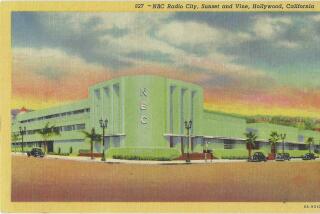RADIO BUFF SHOWS HIS STUFF ON KOCE
- Share via
Cal State Fullerton instructor Mike Adams has turned a lifelong love affair with the radio into a five-part television series that debuts Sunday on KOCE-TV, Channel 50.
“Radio Collector,” written, hosted, produced and directed by Adams, gives viewers an overview of radio history but also focuses on collection and restoration. Each episode of the show, which will air Sundays at 5:30 p.m. through Dec. 1, includes interviews with collectors and a segment on the continuing restoration of an antique radio.
Adams, 42, is a collector himself, and the Yorba Linda home he shares with his wife, Barbara, and their three children is filled with more than 150 old radios culled from thrift stores and swap meets. His interest dates back to his Ohio childhood, when he would tour repair shops with his wagon and ask for old radios that he could bring home and pull apart.
“I got into tinkering with devices,” Adams recalled in an interview in his Cal State Fullerton office. As teen-agers, he and his friends became ham radio enthusiasts. “I was a nerd,” Adams said, matter-of-factly. “Nowadays we’d be into computers.”
After high school, he worked in Ohio radio for 14 years, squeezing in his studies and eventually earning a master’s degree in film and television from Ohio State University. He moved to California in 1974 and landed his current teaching position in 1982. He teaches video and audio production classes, as well as courses in writing for radio, television and film.
It was about three years ago, at a Hermosa Beach shop called the Old Radio Collector that has since closed, that Adams got the idea for his project. At first he planned a single feature on the shop’s owner, Jack Dempsey (not the boxer), but “there was so much, I decided to do a series,” Adams said.
Research for “Radio Collector” took about a year. Then, with the support of Cal State Fullerton’s communications department and the assistance of student technical crews, who received independent study credit for their work, Adams shot 50 hours of videotape, including interviews with historians, collectors and pioneer broadcasters and engineers. A year of editing and production resulted in the final version of “Radio Collector.”
Adams did the series without the luxury of a budget, using student help and university equipment, and when he finished the series he had no means of putting his final tape into broadcast format. He was prepared to pay the $5,000 processing cost himself, but KOCE stepped in and offered to do it in exchange for a chance to air the series. Adams was more than willing and says, “KOCE really saved me on this.”
“Radio Collector” takes viewers through the history of radio and includes a segment on the “golden age” of radio programming, from the mid-1930s to the mid-1950s. Adams, as series host, also visits radio swap meets and the homes of collectors. In a continuing segment, Adams buys a beat-up 1929 Silverstone radio in a thrift shop and restores it with the help of Orange County craftsman Bruce Westoby.
Although “Radio Collector” is in the midst of a run on Los Angeles educational station KLCS-TV, Adams considers the KOCE broadcasts to be his “premiere.” According to Adams, public broadcasting stations in San Diego and San Francisco have shown interest in airing the series, and KOCE has offered to distribute “Radio Collector” over the regional PBS network.
Another series, “Historical Radio,” is an outgrowth of “Radio Collector.” Cal State Fullerton students took Adams’ leftover footage and turned it into a 14-part series that is sent over the university’s cable station, Channel 33, which goes to cable customers in Fullerton, Placentia and Anaheim. The first seven segments aired last semester, with the remaining seven running this semester.
Adams said he is amazed at seeing three years of work finally show up on television. “When I saw the listing in TV Guide, I knew I’d arrived,” Adams joked. He is already working on ideas for a new project, perhaps on the history of television or on efforts to rescue and restore aging theater pipe organs.
Adams received no payment for his work on the series; he says he considers it part of his job as a faculty member. “If you teach it, you ought to do it once in a while,” he said.
More to Read
Sign up for Essential California
The most important California stories and recommendations in your inbox every morning.
You may occasionally receive promotional content from the Los Angeles Times.










